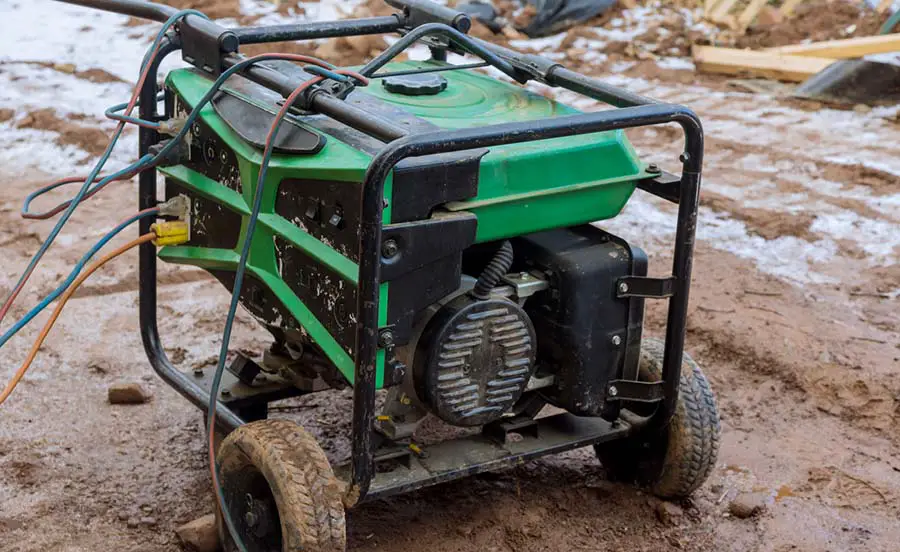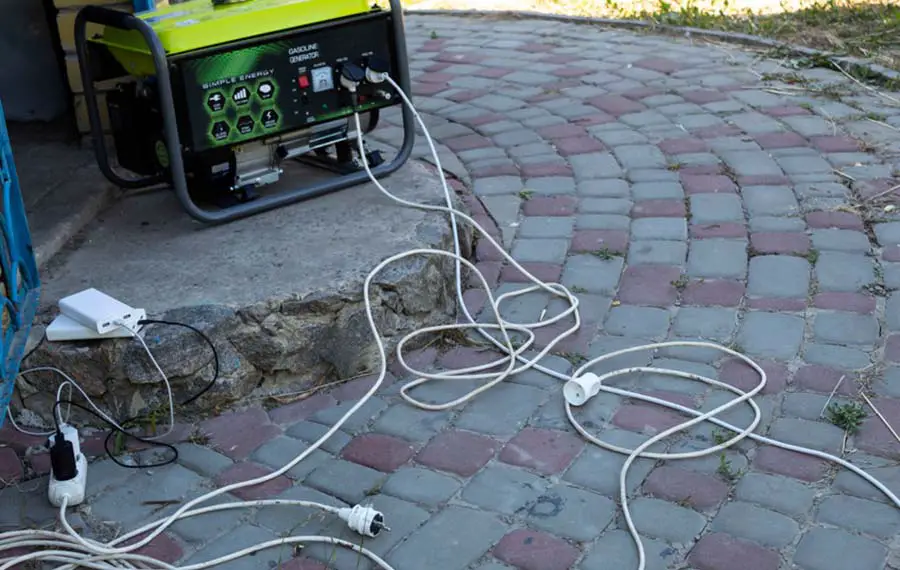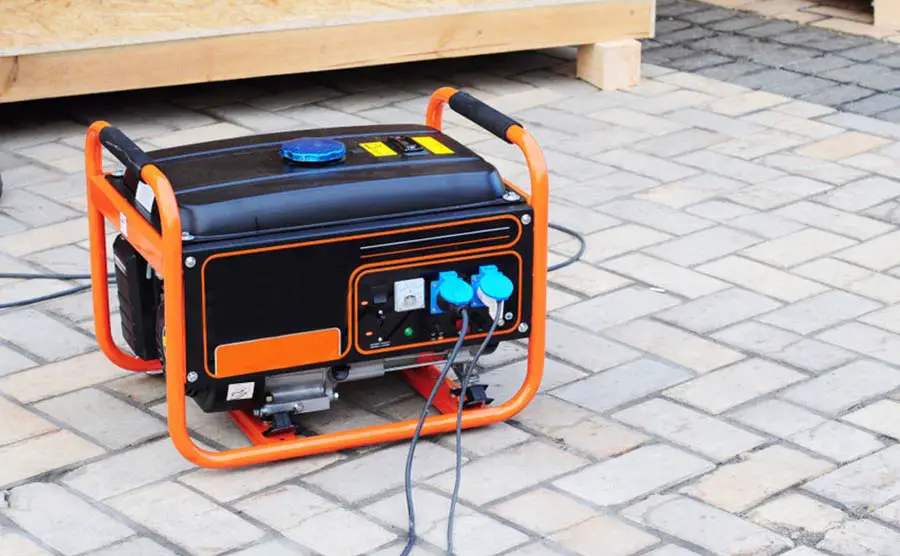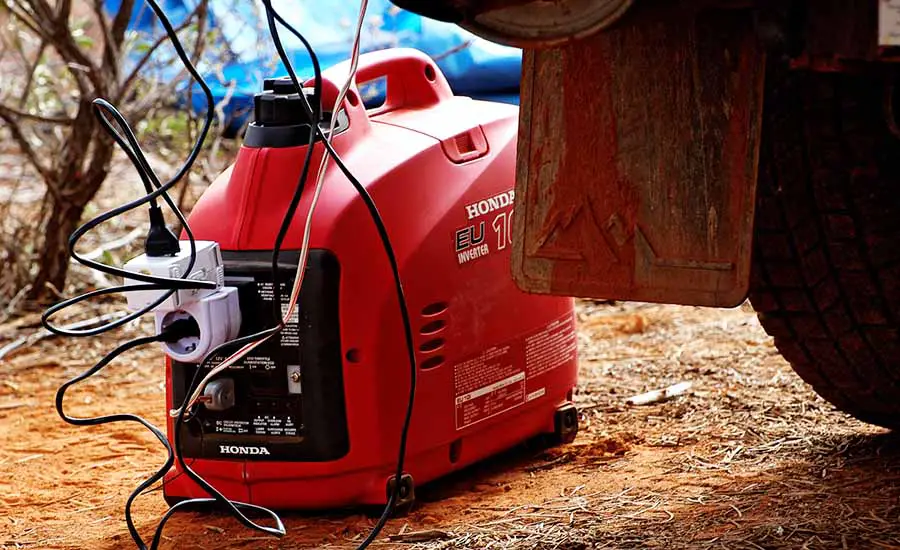
When there’s an unexpected power outage, a generator can come to your rescue as a backup power source. You can use your generator to power your necessary electronics until the grid power comes back on. However, when you exceed your generator’s load capacity, it can result in your generator becoming overloaded.
To fix an overloaded generator, switch the machine off and disconnect all cords and appliances. The combined wattage of connected devices must be lower than the generator’s max capacity. Once you’ve disconnected enough devices to lower the wattage to acceptable levels, restart the generator.
In this article, we’ll break down everything you need to know about overloaded generators. First, we’ll look at the signs a generator is overloading and the risk of this. Once we’ve done this, we’ll guide you through fixing the issue and tips for preventing overloading in the future. Let’s get started!
How to Fix an Overloaded Generator
When a generator is overloaded, it means that you have exceeded your generator’s wattage limit. In turn, this is a sign that you’ve connected too many appliances to the generator. The combined wattage of the connected devices likely exceeds what the generator is capable of producing.
When you exceed this wattage limitation, your generator will not be able to perform optimally. If there’s a circuit breaker, your generator will automatically turn off. However, if you don’t have a circuit breaker, you’ll likely notice the common signs of an overloaded generator.
Here are the basic steps that you should take to fix an overloaded generator:
- Turn off the generator
- Disconnect all electrical appliances
- Determine the cause of the overload
- Restart the generator
- Reconnect the right number of appliances
1. Turn the Generator Off
If your generator has a circuit breaker installed, it will automatically switch off once it detects an overload. Alternatively, if you’ve noticed the signs of an overloaded generator that is still running, you should turn it off immediately. You should let the generator cool down before proceeding to examine it any further.
2. Disconnect Any Connected Electrical Appliances
Once you’ve switched off your overloaded generator, make sure to disconnect any electrical equipment or appliances connected to your generator. Remember, an overload is caused by exceeding the recommended wattage limitation of your generator! Unplugging all connected devices will help you in the following step.
3. Determine the Cause
The next step towards fixing an overloading issue with your generator is to determine if it was, in fact, an overload. Determining whether or not your generator experienced an overload is twofold.
Firstly, you’ll want to check the wattage limitation of your generator. If this does not have a marking on the generator itself, you’ll be able to find the necessary information in the owner’s manual. Knowing this limitation is crucial to fixing an overload and preventing one in the future.
The next step would be to determine whether or not your connected appliances exceeded the generator’s load capacity. To do this, you’ll need to factor in how much power the various devices utilize. This means taking into account both running and starting wattage values.
Appliances like fridges require more power to start, called a starting wattage. This may differ from the running wattage the appliance requires to stay powered. Essentially, you need to ensure that the combined wattage of your connected appliances does not exceed that of the generator.
If you noticed that your appliances exceeded the denoted load capacity, it was an overload your generator experienced. If your appliances did not exceed the wattage limitation, there is likely a different underlying issue that you need to address.
4. Restart the Generator
Once you’ve completed the previous steps, you’re ready to restart your generator. When restarting your generator, the electrical appliances must remain disconnected. The instructions to restart your generator may differ between brands and models.
Typically, you will need to hold the reset or power button on your generator for a few seconds to restart your generator. If the generator has an overload indicator, this should now be off. Alternatively, the signs discussed earlier should have ceased.
5. Reconnect Electrical Appliances
Now that your generator is back up and running, you can reconnect your electrical appliances. When doing this, it’s important not to exceed the designated load capacity of the generator. After all, that’s what causes the overload in the first place.
Once you’ve reconnected your electrical appliances with this wattage limitation in mind, your generator should be performing optimally again. If signs persist, it could be a sign that you’re still exceeding the wattage limit. You can try repeating this process and connecting fewer electrical appliances.
If you’ve completed this process and the signs persist, it could mean that the overload has resulted in lasting damage to your generator. In this case, you should have your generator assessed by a qualified professional to determine the root of its problems.
Signs That a Generator is Overloading

Many modern portable generators have circuit breakers built into them. When the generator is overloaded, these circuit breakers will cause an overloading or overloaded generator to turn off. However, not all portable generators have these circuit breakers installed.
For this reason, you must be able to identify the different signs that a generator is overloading. After all, recognizing this is the first step towards fixing a generator that is overloaded. Let’s take a look at the five main signs a portable generator is overloading!
1. There’s a Reduced Output of Power
One of the most common symptoms of an overloading generator is a noticeable reduction in the power output from the portable generator. When your generator is overloaded, it will not be able to perform optimally.
Every generator will have a wattage limitation. You need to be aware of your generator’s limitation, as exceeding this wattage limitation by powering too many appliances could result in an overload. When this happens, you’ll have poor performance and reduced output of power from your generator.
If you have lights connected to your generator, you’ll be able to notice this reduction of power by observing the connected lights. When your generator becomes overloaded, you’ll notice lights flickering or changing in intensity.
2. The Generator is Overheating
Another clear sign that a generator is overloaded is when it begins overheating. For a portable generator to operate efficiently, you should place it outside away from any structures and has the appropriate ventilation.
When your portable generator starts overheating, despite being placed in an area that meets the criteria mentioned above, it’s a sign that your generator is overloading. Commonly, overheating occurs in portable generators that do not have circuit breakers. When your generator is overheating, it’s important to turn it off and let it cool down.
3. There’s Soot in the Generator’s Exhaust
Finally, another sign that a generator is overheating is when there is soot residue on the generator’s exhaust. Of course, portable generators emit carbon monoxide, which can have a dark appearance. However, soot should not be left behind from this.
If you notice leftover soot in your generator’s exhaust, it could indicate that the generator has overloaded or another underlying issue. Before you examine the exhaust of your generator, you should always turn off the machine. Remember, carbon monoxide is poisonous and potentially lethal!
4. There’s Smoke Coming from the Generator’s Vents
As we mentioned earlier, a generator requires proper ventilation to function. That is why portable generators will have vents fitted in them. If you notice smoke rising from your generator’s vent – or, worse, notice sparks coming from within – it is a sign that your generator is overloaded.
Generally, this is more common in generators without circuit breakers. When you notice smoke or sparks through your generator’s vent, it’s a sign that your generator has been overheating for a long time due to an overload.
5. The Cooling Fan Stops Spinning or Becomes Louder
You can install a cooling fan to help ventilate your generator better. Cooling fans keep your fan running cool optimally – but only when you adhere to the maximum wattage limitation of the generator.
If you notice that your generator’s cooling fan has stopped spinning altogether or that it has suddenly become louder, it’s a sign that your generator is overloaded. Under these conditions, the sound will change the longer the generator keeps running. You should turn off your generator immediately to prevent damage.
The Risks of an Overloaded Generator

In the previous section, we looked at the signs of an overloaded generator. Recognizing these signs is, of course, crucial to repairing your overloaded generator. However, identifying these signs is vital as there could be disastrous consequences of an overloaded generator.
There are many risks to an overloaded generator, some more serious than others. These risks are why it’s so important to recognize and repair an overloading or overloaded generator.
1. The Risk of Damaging the Generator
Regardless of the type of generator that you’re using, a generator is a costly investment to make. When your generator becomes overloaded, it can result in long-term damage to your generator. This can drastically shorten the lifespan of your investment.
When your generator is overloading and is functioning above capacity – particularly when there is no circuit breaker installed – it can damage the generator’s internal components. For example, you could inadvertently burn out the alternator.
2. The Risk of Damaging Other Electronic Equipment
When your generator becomes overloaded, it can result in a brief surge of intermittent power. This is because your generator is attempting to function above capacity to supply power to the connected appliances.
Not only can overloading damage your generator, but it can also damage other electrical appliances in the process. When your source of power is malfunctioning – even a backup source – your connected electrical equipment can be damaged as a result. This can be a costly consequence of an overloaded generator!
3. The Risk of a Fire or Explosion
Generators typically utilize gasoline to function. That is why an overloading and overheating generator can be so dangerous! If you don’t notice your generator overloading for a long time, it can result in a fire or even an explosion.
That is why people must recognize the symptoms of an overloading generator. Whenever operating a generator, it’s essential to monitor its performance to prevent a fire or explosion from happening due to overloading.
Tips for Preventing an Overloaded Generator

There are many potential risks of an overloaded generator. While it is possible to fix a generator that has experienced an overload, preventing an overload in the first place is equally important.
1. Get Your Generator Inspected and Serviced
If you’ve recently experienced issues with overloading your generator, it would be a good idea to have it inspected. You may need to have your generator serviced. As a general rule of thumb, you should service your generator at least once annually.
When maintaining your generator, change the filters and oil. Furthermore, any issues you’ve been having can be addressed by a professional. By routinely getting your generator serviced, you can ensure that it remains in good working condition.
2. Use Quality Replacement Parts
Often it may be necessary to replace certain components within your generator. For example, we mentioned earlier that overloading a generator can damage specific components. Regardless of the reason, you should opt for high-quality replacement parts when you need to replace any of these components.
Whether you’re replacing fuses or circuit breakers, the quality of your replacement parts makes a difference in how your generator functions. Using parts that have the wrong ratings or are inferior to the quality of the original parts can negatively impact the performance of your generator.
3. Upgrade to a Larger Generator
As discussed earlier, when a generator becomes overloaded, it’s a sign that you have exceeded the generator’s load capacity. If you’ve found your generator is simply not big enough to power all of your necessary appliances, you may want to consider upgrading to a new generator.
Using the same method discussed in step three of the previous section, you can calculate how much power your generator needs to produce to power your essential appliances. By doing this, you can find the perfect generator for your backup power needs.
There are plenty of generators for you to choose from. You could opt for an ARV generator, which stands for automatic voltage regulation. These generators allow you to easily maintain a set voltage, which prevents your generator from being overloaded.
Alternatively, you could even consider upgrading to a standby whole house generator. While these systems may be costly to install, they can easily power all of your necessary electrical equipment and supplies. Standby generators are not only hassle-free, but they’re also safer and easier to maintain.
Conclusion
In this article, we looked at how to fix an overloaded generator. We broke down everything you need to know, from recognizing the signs of an overloaded generator to fixing and preventing this from occurring again.

